Claim Back Your Space: Working With Nature
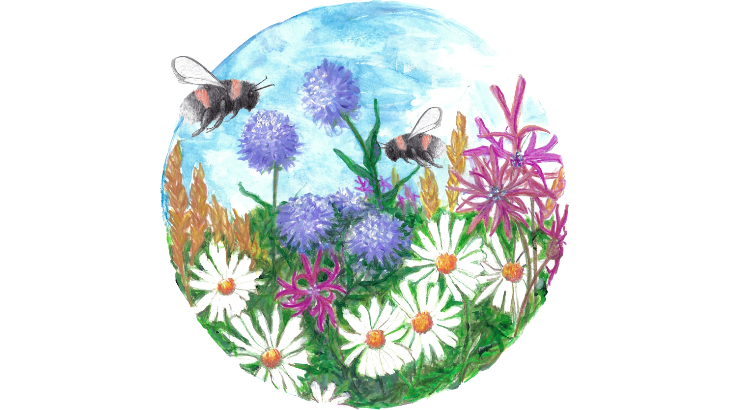
These notes for any group interested in a small rewilding project were written for CA-WN by Brian Webster and illustrated by Clare Robertson-Marriott
Before you start
Any space can be rewilded by just standing back and letting nature get on with it, and many of our richest wild places were shaped this way.
If the soil is nutrient poor this may be a good idea but all too often what you end up with are nettles, thistles and other nitrogen-loving plants. These are all important to have as they support a huge variety of wildlife. Several of our most colourful butterflies need nettles as food for their caterpillars, and young nettle tops make a delicious soup to warm us up in spring!
These suggestions are aimed at a parish-sized area, but can be scaled down even for the average front garden or a strip of roadside verge.
Remember, a humble, gentle approach is key, costs should be minimal, and time, thought and effort the main inputs.
“The longest journey begins with the first step.” So goes the old Chinese proverb, so let’s get to it.
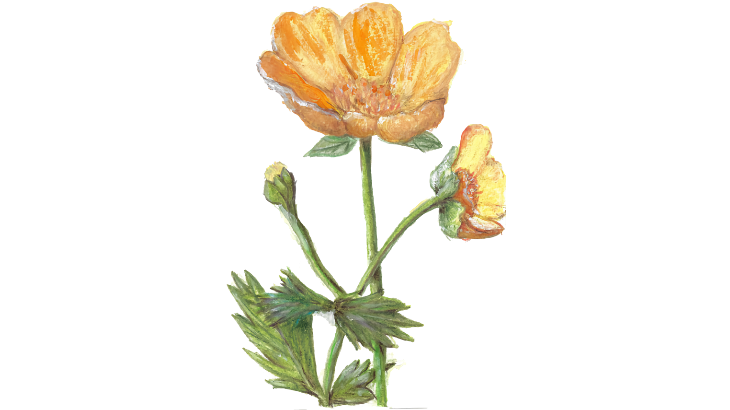
First steps
Assuming you already have a nucleus of interested folk raring to go, what next?
The local authority, usually the Parish Council, will need to know about your ideas. If you are lucky they may have someone with the know-how to start you off. Indeed they may be ready to point you towards suitable areas for a project, and small grants may be available to help with costs. In any event, they need to be kept informed of your plans from an early stage.
Small pockets of land, only a few square metres let’s say, may just need a close cut in April and again in September when most wild flowers are over, with the clippings carefully raked off. Mowing and raking is important, the idea being to gradually starve the soil of nutrients. This favours the flowering herbs rather than the grasses.
Often there will already be a handful of species like daisies, buttercups, dandelions and so on surviving with a circle of leaves hugging the ground. All they need is freedom from mowing to give them time to flower and set seed. Other kinds will gradually find their own way in, paragliding on the wind or from seeds dropped by a bird or small mammal.
Larger areas should first be surveyed to find out what is already there. While it is possible to an extent to do this using the many books and online guides that are available, a word of caution is needed. Many valuable wildlife communities have been damaged or destroyed by well-meaning amateurs blundering in. Like any other worthwhile pursuit it takes many years of patient observation to gain a degree of expertise. What appears to the untrained eye to be just an eyesore may be home to a whole community of rare plants and animals.
So it is vital to find someone with the necessary knowledge to spend some time making a list of what is already there. You may be lucky to have such a person within your group or living in the area who can do this. If not, the local Wildlife Trust should be approached. Every county or group of counties has its own Wildlife Trust. In West Northamptonshire this is The Wildlife Trust BCN; their contact details are at the end of this post.
At an early stage seek to involve the local school. With an enthusiastic teacher on board a whole range of exciting projects opens up. Suggestions include: setting up a mini tree nursery, from gathering the wild seed in autumn to sowing and growing on the seedlings, then planting out on your site(s); children should be encouraged to help on your site from the beginning, it goes without saying always under competent supervision; keeping records of wildlife, etc. Classroom visits to a site can be an invaluable teaching resource.
A bonus is that children who have been actively involved in planning and developing the project, and encouraged to think of it as their own, will continue to take pride in and care for the site as they grow up.
It cannot be overemphasised that what appear to our eyes derelict sites may harbour important wildlife communities. For example a sheet of corrugated iron turned over on an abandoned industrial site may hide slow worms: that rotting post you plan to burn may have rare lichens or mosses growing on it or small creatures hidden in its crevices.
Of course if a site is found to be hazardous to humans in any way action to make it safe will need to be taken. Generally this will need expert guidance and is outside the scope of these notes. So ‘make haste slowly’ should be your maxim. Having thought your project through and prepared plans, only then may you begin any necessary work on the ground.
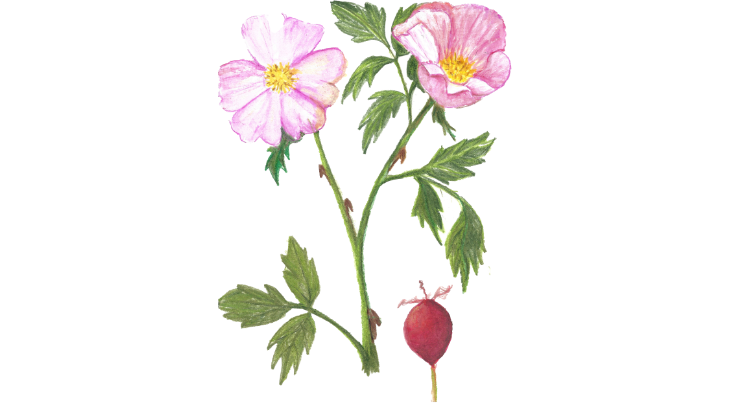
New plots
• Start gently
• Respect what is already there
• Seek expert advice for larger plots
• Mow in April and September, raking off clippings
• Existing wildflowers will flourish with less mowing
• More species will colonise naturally over time
Preparing your plot
It is likely your project will look scruffy, especially in the early stages. Nature is like that, so it is important to keep the general public informed of what you are trying to do. Towards summer’s end grasslands especially look untidy as the foliage begins to die back. This is the time to be patient. Waiting until September to give it the second short back and sides gives the flower seeds time to ripen and fall to the ground. Then move in with the mowers and cut as close to the ground as possible.
The most important thing is to rake off as much of the cut material as possible. Vigorous cutting and raking will help shake any seed still in the seed heads free to disperse, to grow and flourish the following season.
Aim to cover small segments at a time. Take on too much and things can quickly start to go adrift, and get out of control. More importantly if things start to go astray it is possible to backtrack and start again. Above all be patient. You will be working at nature’s pace and she will not be hurried.
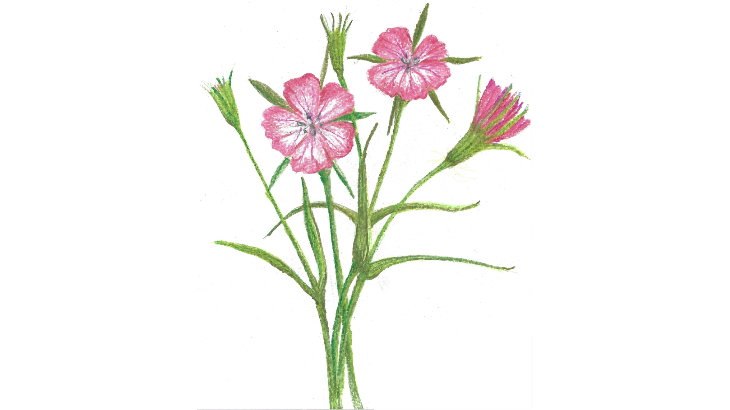
Flower-rich grasslands
Any bare ground could just be left to see what grows there but be aware that you may end up with mainly nettles and thistles. These are all valuable to wildlife; nettles are food for many butterfly and moth caterpillars.
You may decide to sow bare ground with a wildflower seed mix – there are a host of choices online. But once again local is best. Why not put a paper bag in your pocket and harvest some when you are out and about on your walks? It is easy to snip off a few seed heads or shake some into your bag, always being careful to leave plenty behind.

One wild flower I would say is a must have and that is hay rattle, also known as yellow rattle. A foot or so high, it has small yellow flowers followed by papery seed cases in which the ripe seeds rattle when shaken. It is what the botanists call a hemi- parasite. Although capable of relying on its own roots for food it loses no chance to invade the roots of nearby grasses. It does this to steal food from them. This weakens the grasses giving other wild flowers the chance to thrive. Again look for supplies online, unless you know somewhere it grows near you.
Wild-harvested seed of most kinds benefit from being stratified if they are to germinate well. This involves making sure they are chilled over the winter, mimicking outside conditions.
After thoroughly drying your seeds in a warm room, put them in a moisture-tight container and keep them in the salad drawer of your fridge for a few weeks before you sow them.
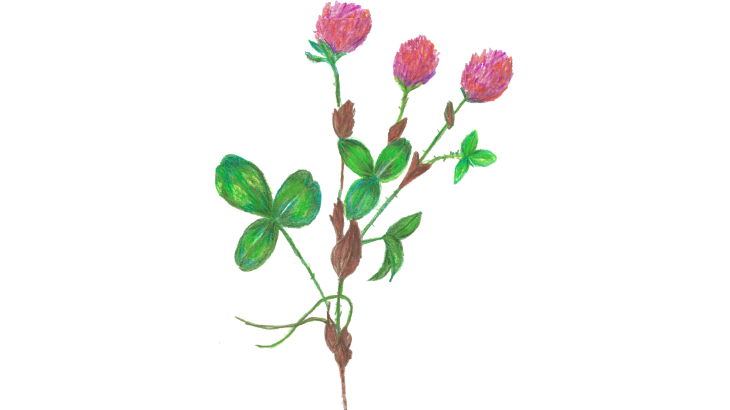
No need to dig your plot over but do rake it over vigorously to loosen the top inch or so of soil. Remove unwanted seedlings like nettles and docks that have germinated or they will quickly smother the other plants. Best time is early spring when the soil has dried out a bit and the risk of hard frosts has passed.
As with any other wilding project your wild flower meadow will improve year by year, and just think of the bees, butterflies and others that will be attracted. You can be proud!
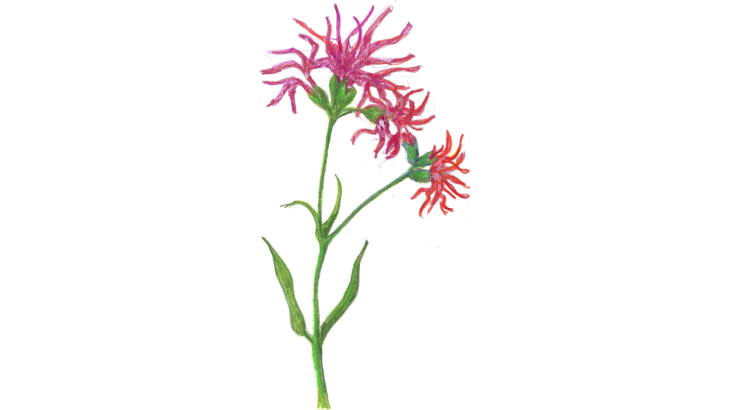
Tree planting and aftercare
However small your area try to find space to plant a few trees and shrubs, or even better a small grove that will grow on to delight future generations. Don’t run away with the idea that woodland is merely a matter of planting a few trees. It takes centuries for a new planting to even approach wildlife-rich maturity, and that’s the whole wondrous point. Done with care and sympathy you can think of your work as being for posterity. There surely can be no greater legacy than that.
As already outlined, trees nurtured from seed you have harvested locally should be the aim. This is because such trees should be adapted to local conditions, and as in pretty much anything else environmental, local is best.
Buy trees in, if you must, from a reliable supplier like the Woodland Trust. Only if locally sourced trees cannot be obtained should others be sought. Avoid imported trees as they may harbour unwanted diseases.. Think Dutch elm disease and ash dieback. Both of these came in this way.
Oak, hawthorn, beech, ash, large-leaved lime, silver birch and rowan are all good in normal soil. In areas that are permanently damp the willows, sallows and alders are suitable. Avoid planting into waterlogged soil.
Newly planted trees must be well watered until they are established. A tree guard is necessary where rabbits and other browsing animals are present. Environmentally friendly non-plastic ones are available from the Woodland Trust - see Useful sources of information at the end of this post.
Bushes that will thrive include English privet, blackthorn, buckthorn, elder, and dogwood. All may be harvested and grown on in your nursery.
Brambles should be encouraged not only for their fruits but also for their nectar-rich flowers. Likewise climbers such as honeysuckle, its nectar being sought after by long-tongued moths. Many of these may be increased by taking cuttings, but too many of these is not a good idea as they will be genetically identical to the parent plant.
Ponds
Even the smallest of ponds will be a magnet for wildlife, so do try to find space for one. Site it where it is not too close to trees, yet benefits from some shade in hot weather. It should be at least two feet deep so that it does not freeze solid in hard winters. Part of it should shelve gently to a shallow end so that birds, hedgehogs and other animals that fall in may find a way to crawl out.
A newly built pond may just be left to see what comes in. It is amazing how soon pond skaters fly in, often appearing within hours. But some water plants like purple loosestrife, arrowhead, bur-reed, yellow irises and reeds may be planted around the edges. Again seek them from local sources wherever possible. Water lilies are really suitable only for larger ponds. Likewise fish are not a good idea as many species are predators and could decimate other wildlife.
Duckweed with tiny flat leaves lying flat on the surface will almost certainly appear. Don’t be alarmed if it entirely covers your pond, as it provides shade and shelter while letting plenty of light through to the creatures below. Over time these may include water boatmen, dragonfly nymphs, water beetles, and of course frogs, toads and newts.
Periodically you will find it necessary to clear your pond as it becomes clogged up with leaves, silt and other debris. This should be a winter task when much of the wildlife is dormant. Leave some of the cleared material close to the edge for a while so that any active creatures may find their way back into the water. All cut material should be removed to the compost heap to rot down.
We hope these basic notes have been helpful to you and wish you every success with your project. Be assured you will be making a very real contribution towards helping our wounded environment recover from the battering of recent decades. What can be more rewarding than that?
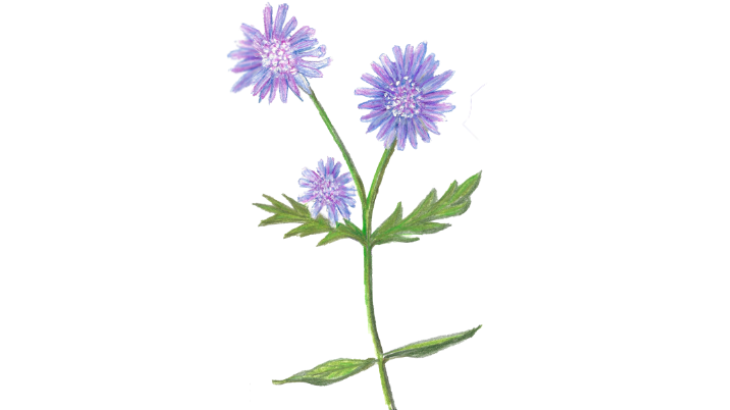
SEED AND PLANT SUPPLIERS
All these plant suppliers use peat-free compost
Bee Happy Plants
Lakehayes (Organic) Nursery, South Chard, South Somerset TA20 2NZ
Blisworth Wild Flower Nursery
4a Northampton Road, Blisworth, Northamptonshire NN7 3DN
Emorsgate Seeds
Limes Farm, Tilney All Saints, King's Lynn, Norfolk PE34 4RT
Rosy Bee
Maypole, Monmouth NP25 5QH 07710 096734
Swallow Nursery and Plant Centre
Evenley Road, Mixbury, Brackley, NN13 5RR
USEFUL SOURCES OF INFORMATION
Buglife
G06 Allia Business Centre, London Road, Peterborough PE2 8AN
Butterfly Conservation Trust
Manor Yard, East Lulworth, Wareham, Dorset BH20 5QP
Plantlife
Brewery House, 36 Milford Way, Salisbury, Wiltshire SP1 2AP 01722 342730
Wildlife Trust BCN - Bedfordshire, Cambridgeshire and Northamptonshire
Lings House, Billing Lings, Northampton NN3 8BE 01604 405285
Wildlife Trusts (find the Trust for your county)
Woodland Trust
Kempton Way, Grantham, Lincolnshire NG31 6LL
READING LIST
The Garden Jungle: or Gardening to Save the Planet
by Dave Goulson, published by Vintage (2020)
Feral: Rewilding the Land, Sea and Human Life
by George Monbiot published by Penguin (2014)
No Nettles Required: The Reassuring Truth About Wildlife Gardening
by Ken Thompson, published by Eden Project Books (2006)
Wilding
by Isabella Tree, published by Picador (2018)
Woodland Creation Guide
by S. Herbert, A. Hotchkiss, C. Reid and K. Hornigold, published by Woodland Trust (2022), available at
About our author and illustrator
Brian Webster is an ecologist who has spent a lifetime working in and sharing his knowledge of the natural world.
His varied career has included overseeing initial development of the 245-acre Robinswood Hill Country Park in Gloucestershire as Warden Supervisor, Natural Sciences Officer caring for major geological and natural history collections at Northampton Museums, and Fishing Warden at Pitsford Water.
In the educational sphere, he has taught courses on aspects of wildlife conservation, ecology, and environment in a range of settings, and worked with students from infants to A-level to help them learn about their place in nature.
Clare Robertson-Marriott writes
"It is natural and necessary to develop an affinity with nature. Drawing wild plants and animals requires a close examination. I enjoy the botanical study of the structure of plants and to learn of their character and movement in the field, and the communities in which they grow. The more one looks, the more beautiful they become. Drawing plants brings peace and affinity with them. However, we do need to plant more of them".
